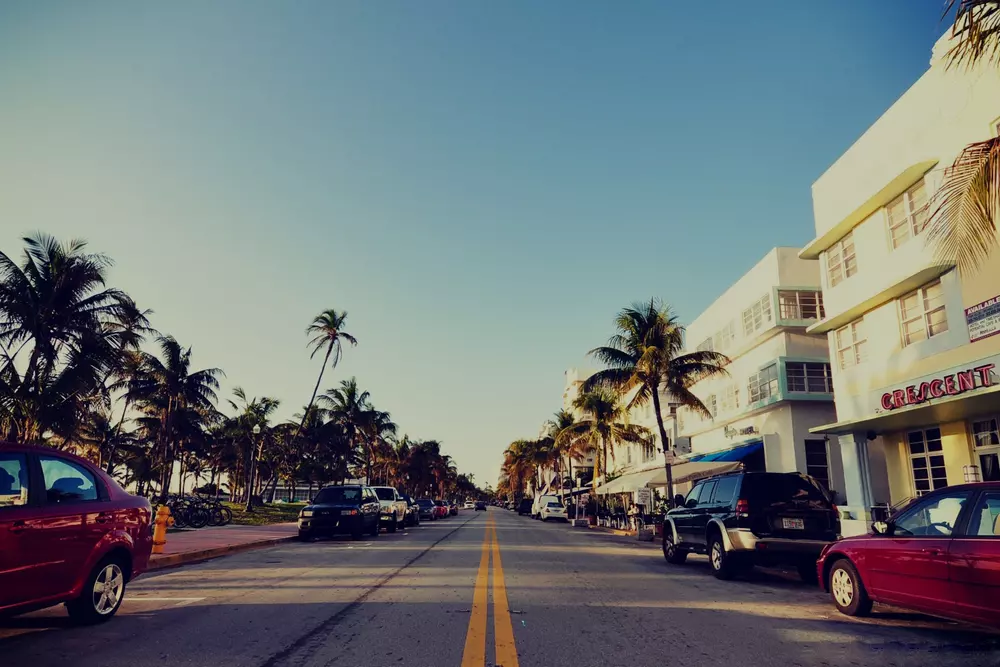America is a land of trends. Here, people don’t just wear clothes — they live in them, express themselves, argue, love, protest, and experiment. This is especially true for the youth. Teenagers and young adults in the U.S. choose clothing not just for style, but for meaning. For the brand’s philosophy. For its social message. And, to be honest, for how the look will play on Instagram or TikTok.
Today, a T-shirt is more than just fabric. It’s a statement. A meme. A moment. In a world where visual communication moves faster than words, appearance is the clearest way to say who you are.
If you’ve ever walked the streets of New York, Los Angeles, Austin, or Miami, you’ve probably noticed: American youth dress casually, but with a sharp sense of style. That’s thanks to local brands — the ones born in skateparks, garages, music basements, or on the streets of Brooklyn. The ones that started with small prints and became the voice of a generation.
American youth brands aren’t about “buying clothes.” They’re about “feeling like yourself.” About freedom. About irony. About street truth. About pushing back against the norm.
That’s why we’ve put together a list of iconic brands that American youth are choosing today. These aren’t just trendy names — they’re flags worn by thousands of young people. They’re street energy, woven into fabric. They’re a style you want to live in.
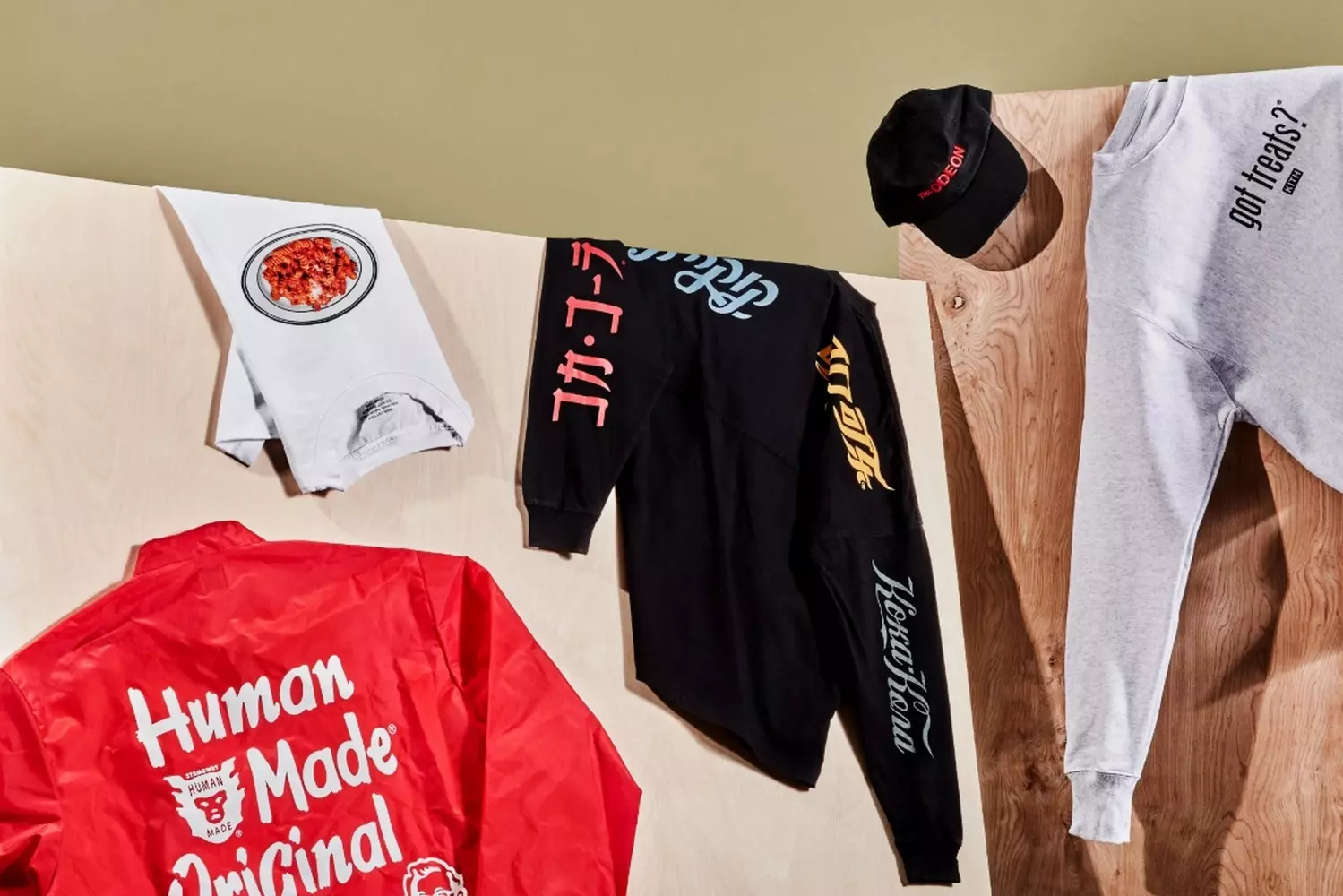
In the 1980s, an unexpected trend emerged in New York: teenagers from wealthy neighborhoods began stealing or buying worn-out Air Force 1 sneakers from homeless people, captivated by their authentic look.
Supreme: When the Street Makes the Rules
City of origin: New York
Founded: 1994
For: Those who feel the city’s rhythm and live on the edge of mainstream and underground
Supreme is more than a brand — it’s a cultural phenomenon. The story began in 1994 in a small skate shop on Lafayette Street in Manhattan. Inside — concrete walls, ramps, graffiti. Outside — a bunch of teens in oversized hoodies, covered in pins, kicking their skateboards around. Nothing glamorous. Just vibe. Just energy.
The brand’s founder, James Jebbia, is a Brit inspired by New York’s skate culture, punk movement, and minimalism. He didn’t set out to build a fashion house — he just wanted clothes for his crew, stuff you could skate in, hang out in, go to shows in. Turns out, that was the beginning of one of the most influential streetwear brands of the 21st century.
"We don’t put our logo on just anything. We put it where it speaks." — James Jebbia
Supreme quickly became a symbol of resistance to mass fashion. Their tees often looked like jokes about consumer culture, and their hoodies — like street philosophy. One of their most iconic designs is the logo in the style of Barbara Kruger (white Futura Bold Italic font on a red background), which became both an icon and a meme.
Why young people choose Supreme
- Limited drops
New collections drop every Thursday. Items sell out fast, especially the rare ones. This creates hype and a sense of exclusivity. - Genre-defying collaborations
Louis Vuitton, The North Face, Nike, Vans, Champion, Stone Island, even artist Damien Hirst and Japanese graphic legend Takashi Murakami. Supreme knows how to mix art, sports, punk, and luxury. - Irony and boldness
T-shirts with Kate Moss portraits, stickers saying "F*** the president", skateboards with texts referencing religion, capitalism, death, and life in the big city. - The “insider” vibe
Supreme doesn’t shout — it whispers to those “in the know.” It’s not a brand for everyone, and that’s its power.
Fun facts
- In 2017, the Supreme x Louis Vuitton collab rocked the fashion world. A luxury giant and a streetwear icon did the impossible — they fused classic and chaos. Lines wrapped around the block, and resales hit tens of thousands of dollars. This partnership marked the moment streetwear conquered high fashion.
- Supreme was one of the first to implement the limited drop strategy: weekly collections that sell out instantly. This creates buzz, and rare items (like box logos or Louis Vuitton collabs) resell for thousands.
- The brand is known for provocative prints: from "Fuck Em All" to a collab with artist Andres Serrano, creator of the controversial "Piss Christ" photo series. In 2000, Supreme released a deck featuring Osama bin Laden, sparking a wave of criticism.
Supreme isn’t just clothing. It’s media. It’s protest. It’s a lifestyle. It’s an invitation to play by your own rules — or no rules at all. No matter your age, if you get the code — you’re already part of street culture.
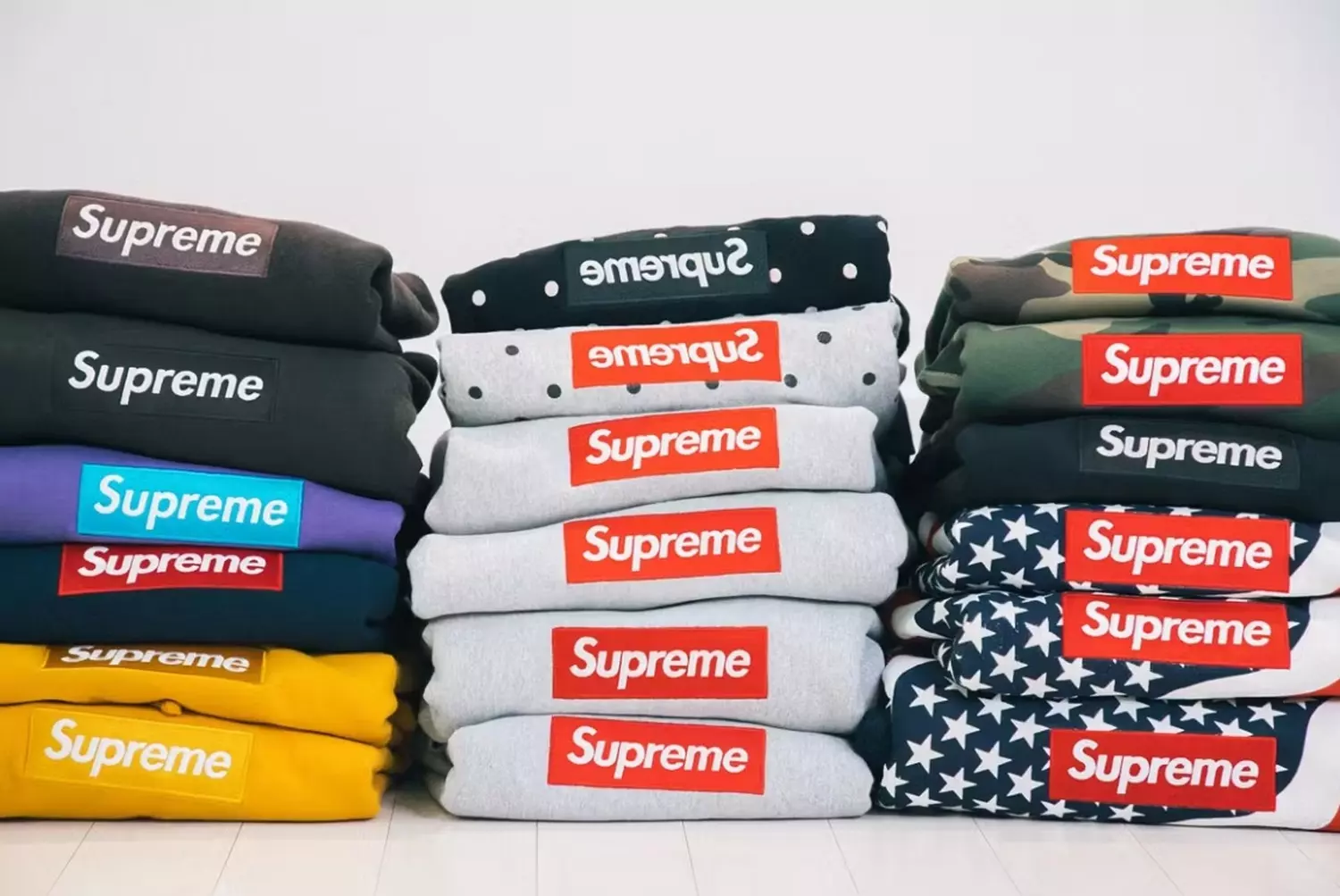
Off-White: High Fashion with a Street Edge
City of origin: Milan / Chicago
Founded: 2012
For: Connoisseurs of art, philosophy, and street hype
Off-White is a streetwear brand with an academic soul. Founded by designer and architect Virgil Abloh — who was both Kanye West’s right-hand man and the creative director of Louis Vuitton’s menswear line — the brand gave fashion a new voice: bold, raw, and unapologetically loud.
At first glance, Off-White might look minimalist. But behind the quotation marks and arrows lies an entire philosophy. The name Off-White (“not quite white”) reflects the brand’s core idea — to exist in the space between black and white, luxury and accessibility, art and commerce. Abloh himself called his style “graphic design in fashion,” clearly seen in his signature prints: stripes, quotes, and slogans like “FOR WALKING.”
"I’m not a designer. I’m a cultural editor." — Virgil Abloh
He flipped the streetwear game, turning quotation marks, brackets, and technical labels into art. His hoodies and sneakers aren’t just clothing — they’re statements, ideas, graphic slogans.
Why young people choose Off-White
- Artistic style
The brand creates more than clothes — it produces wearable art. Every zipper, every “SHOELACES” tag is a deliberate aesthetic choice. - Sneakers turned legends
The Off-White x Nike collab was a game-changer — the “The Ten” collection turned classic Air Jordans, Air Maxes, and Blazers into cult objects. - Streetwear prestige
Wearing Off-White means being on the cutting edge. It’s the choice of those tuned into the creative industries, music, and urban art. - Cultural substance
Each drop revolves around a theme — from urbanism to the Renaissance. It’s not just a “capsule” — it’s a manifesto.
Fun facts
- Off-White became the first streetwear brand exhibited in modern art museums. Some of Virgil Abloh’s pieces are part of the permanent collection at New York’s MoMA as actual artworks. This set a precedent that forever blurred the lines between runway, street, and gallery.
- The 2017 Nike collab “The Ten” reimagined classic sneakers (Air Jordan 1, Air Force 1, Converse) with signature details like zip ties, orange tabs, and text. Some pairs now resell for tens of thousands of dollars.
- In 2018, Abloh became Louis Vuitton’s menswear creative director — the first Black designer in that role in the brand’s history.
- Abloh was close friends with Kanye West (and served as art director for his label DONDA), collaborating with contemporary artists and turning fashion shows into performances. His LV debut took place along the banks of the Seine in Paris, featuring children from around the world.
- After Abloh’s sudden passing in 2021 (at age 41 from a rare form of cancer), the brand continued under New Guards Group (owners of Palm Angels, Heron Preston). While the collections still echo his spirit, Off-White is no longer the same without its founder.
Off-White represents a new kind of fashion — where “street” and “high” are one. Where sneakers can cost as much as sculptures and still carry meaning. It’s clothing that speaks — sometimes louder than words.

The North Face: Urban Style, Alpine DNA
City of origin: San Francisco
Founded: 1966
For: Urban explorers, street romantics, and outdoor-aesthetic fans
The North Face is a brand that grew out of mountaineering but became part of street culture. Originally created for hardcore hikers and climbers, the brand gained cult status in the '90s when streetwear began craving strength and functionality.
Today, The North Face puffer jackets are worn in Harlem, Tokyo, and London alike. The iconic Nuptse Jacket in particular has become a symbol of hip-hop iconography, skate culture, and street style at large.
Why young people choose The North Face
- Durability and comfort
Real outdoor gear adapted for urban life. - Collaborations
Supreme, Gucci, Brain Dead, KAWS — the brand has skillfully embedded itself in pop culture. - Visual identity
Bold logos, oversized silhouettes, and vivid colors — TNF is easy to spot from afar. - The "gorpcore" trend
A style that blends hiking gear with urban outfits — one of fashion’s leading movements in recent years.
Fun facts
- In 2020, The North Face sold more jackets in the U.S. than any other brand — including luxury labels. And that’s in a country where not every region even gets cold.
- The brand name refers to the most challenging side of a mountain in the Northern Hemisphere — the “north face.” It’s a metaphor for overcoming obstacles, embedded in the brand’s DNA.
- Gore-Tex — TNF was among the first to use this membrane fabric, making jackets windproof and waterproof.
- Futurelight — a groundbreaking breathable fabric introduced in 2019.
- Gucci x The North Face (2021) — a surprising luxury collab featuring floral prints and reimagined classics.
- In the 1990s, Nuptse and Denali puffers became must-haves in New York neighborhoods, thanks to rappers like Nas and Wu-Tang Clan. Today, these models are cornerstones of streetwear.
- The first American ascent of Everest (1963) — TNF was involved in designing some of the gear used on that expedition.
- Used by NASA — some of TNF’s technologies were tested for space programs.

True Religion: Salvation by Stitching
City of origin: Los Angeles
Founded: 2002
For: Those who love luxury with street attitude
In the early 2000s, everyone wanted jeans. But not just any denim — they wanted denim as a *fetish*. That’s when True Religion appeared — a brand with signature thick stitching, a smiling Buddha logo, and silhouettes that screamed: “Yes, I stand out!”
True Religion quickly took over the scene — from hip-hop artists to reality TV stars. And while its peak hit in the 2010s, the brand is making a comeback, riding the wave of Y2K nostalgia and the “luxury street” aesthetic.
Why young people are wearing True Religion again
- 2000s nostalgia
The Y2K trend is putting the brand back in the spotlight. - Bold design
Oversized labels, signature stitching, and flashy colors. - Stars are back on board
G Herbo, Megan Thee Stallion, and other new-gen artists are rocking True Religion. - Street luxury revival
The bling-bling meets raw streetwear vibe is trending again.
Fun facts
- The first True Religion stores felt like luxury boutiques — velvet curtains, gold-plated hangers, and cognac for clients. Jeans went for $300+ and people lined up to get them.
- The name “True Religion” refers to spirituality through self-expression. The iconic logo — a laughing Buddha and a horse (symbolizing freedom) — has even inspired tattoos among fans.
- The “V-shaped” stitching on the back pockets became the brand’s calling card — and a blueprint many fast-fashion brands copied.
- Premium materials — Japanese denim, hand embroidery, and 24k gold-plated hardware.
- Price tag above Gucci — in the mid-2000s, True Religion jeans sold for $300–$600, becoming a status symbol among rappers and celebs.
- “Denim mafia” — in 2011, a thief in Los Angeles targeted only True Religion stores, stealing jeans worth $1.5 million.

HUF: Born to Skate
City of origin: San Francisco
Founded: 2002
For: Skaters, underground heads, and everyone who’s “offbeat”
HUF — the name sounds like slang, but it carries serious cultural weight. Founded by Keith Hufnagel, a pro skater who rode for Nike and Supreme before launching his own label. Keith was a 90s skate legend, known for his aggressive style and appearances in iconic Toy Machine and Real Skateboards videos.
HUF started as just a skate shop. But it quickly became a movement — inspired by punk, DIY, urban chaos, and street irony. One of its most iconic symbols? The weed leaf on socks. Not just a joke — a badge of freedom.
Why HUF is cult
- Authenticity
A brand made by skaters, for skaters. - Rebel style
Collages, subversive art, provocation. - Iconic accessories
Their daisy and weed-leaf socks went viral and became legendary. - Independent spirit
HUF is always about being “against the system.”
Fun facts
- HUF’s slogan: “Made by Skateboarders for Skateboarders.” Even as the brand went global, every drop still gets street-level validation from the skate community.
- In 2002, Keith opened the first HUF store in San Francisco, which quickly became a hub for skaters and artists.
- HUF x Nike SB Dunk Low “Friends & Family” (2014) — a rare sneaker with hemp leaf print that became a holy grail for collectors (resale price: $10,000+).
- HUF only collabs with like-minded souls: Thrasher Magazine — a capsule with the iconic “Flame” logo, Grateful Dead — psychedelic prints, Playboy — 70s-inspired erotica.
- Spotted on: Tyler, The Creator — repping HUF since the 2010s, ASAP Rocky — wore it in the “L$D” video, Macklemore — name-dropped the brand in “Thrift Shop.”
HUF is the rebellious soul of skateboarding, captured in simple but perfect pieces. A brand that never sold out to the mainstream — but taught the streets how to dress.

Vans: Born on a Skateboard, Raised on the Streets
City of origin: Anaheim, California
Founded: 1966
For: Skaters, dreamers, indie kids, and students of all generations
Vans has become synonymous with the California spirit. The story began in 1966, when Paul and James Van Doren opened the first Vans store in Anaheim, California. Back then, they offered made-to-order shoes — customers would come in, choose a pair, and get it made on the spot. That hands-on approach immediately caught the attention of local skaters and surfers looking for durable and comfy footwear.
From the very start, Vans focused on what skaters needed most: grip, comfort, and durability. They introduced the now-iconic waffle sole, known for its excellent board feel. Once Vans launched their first model with this sole, it became an instant hit in the skate scene.
Why young people choose Vans
- Affordability
Simple, stylish design at an accessible price — Vans are within reach for most, without compromising on quality. - Iconic models
Silhouettes like Old Skool, Sk8-Hi, and Slip-On aren’t just sneakers — they’re symbols of street culture. They're worn not only by skaters but also by musicians, artists, and indie activists. Old Skool — the first skate shoes with leather and suede uppers, featuring the legendary side stripe. Sk8-Hi — high-tops with ankle support, made to help prevent injuries during skating. Slip-On — the go-to model for those who love minimalism and ease. - Subcultural roots
Vans was one of the first brands to fully embrace diverse subcultures — from skateboarding and surfing to punk and grunge. These kicks aren’t just shoes, they’re a part of cultural movements. - Skateboarding
Vans became a symbol of skate culture. Every skater knew — you don’t land big tricks unless you’re rocking these kicks. - Punk and grunge
Vans became a core part of punk and grunge aesthetics. Legends like Kurt Cobain often wore Vans on stage. - Self-expression
Vans has always encouraged people to be themselves. One of the brand’s coolest aspects? Customization. You can pick your colors, prints, and even design a one-of-a-kind pair with your own art or text. Vans became a blank canvas — a platform for creativity that keeps the brand fresh for new generations.
Fun facts
- Slip-Ons became a pop culture icon after the film “Fast Times at Ridgemont High” (1982). In one scene, Sean Penn wore them — making them a fashion must-have overnight.
- Founder Paul Van Doren opened the first shop selling directly from the factory — no middlemen involved.
- The original model #44 (now called Authentic) was so simple, people called it a “canvas slipper.” But skaters loved it for the sticky sole.
- In the early days, the store often operated at a loss — customers would leave watches and rings as collateral.
- In 1976, the Z-Boys (legendary skate crew) started riding in Vans because the rubber sole didn’t slip off the board.
- Bands like The Offspring, NOFX, Suicidal Tendencies wore Vans on album covers.
- Vans x Supreme (since 1996) — one of the longest and most successful collaborations in streetwear history.
- In the 2010s, Vans ditched traditional advertising in favor of supporting subcultures: skateparks, music festivals, art projects.
- Vans Warped Tour became a legendary festival that united punk rock, skateboarding, and graffiti culture.
- In 2017, the brand dropped pizza-scented sneakers (in collaboration with Pepe’s Pizza).
- Now part of VF Corporation (The North Face, Timberland), Vans has kept its rebel soul alive.
- Models like Old Skool, Sk8-Hi, and Slip-On are worn by everyone — from school kids to fashion designers.
Vans isn’t just a sneaker brand anymore. It’s a symbol of a generation that isn’t afraid to express itself, stand up for what it believes in, and support the culture it loves. Over the decades, Vans has expanded way beyond skate parks — it’s become a true force in streetwear and pop culture alike. And through it all, it’s stayed loyal to its roots and to those who live for freedom, creativity, and authenticity.
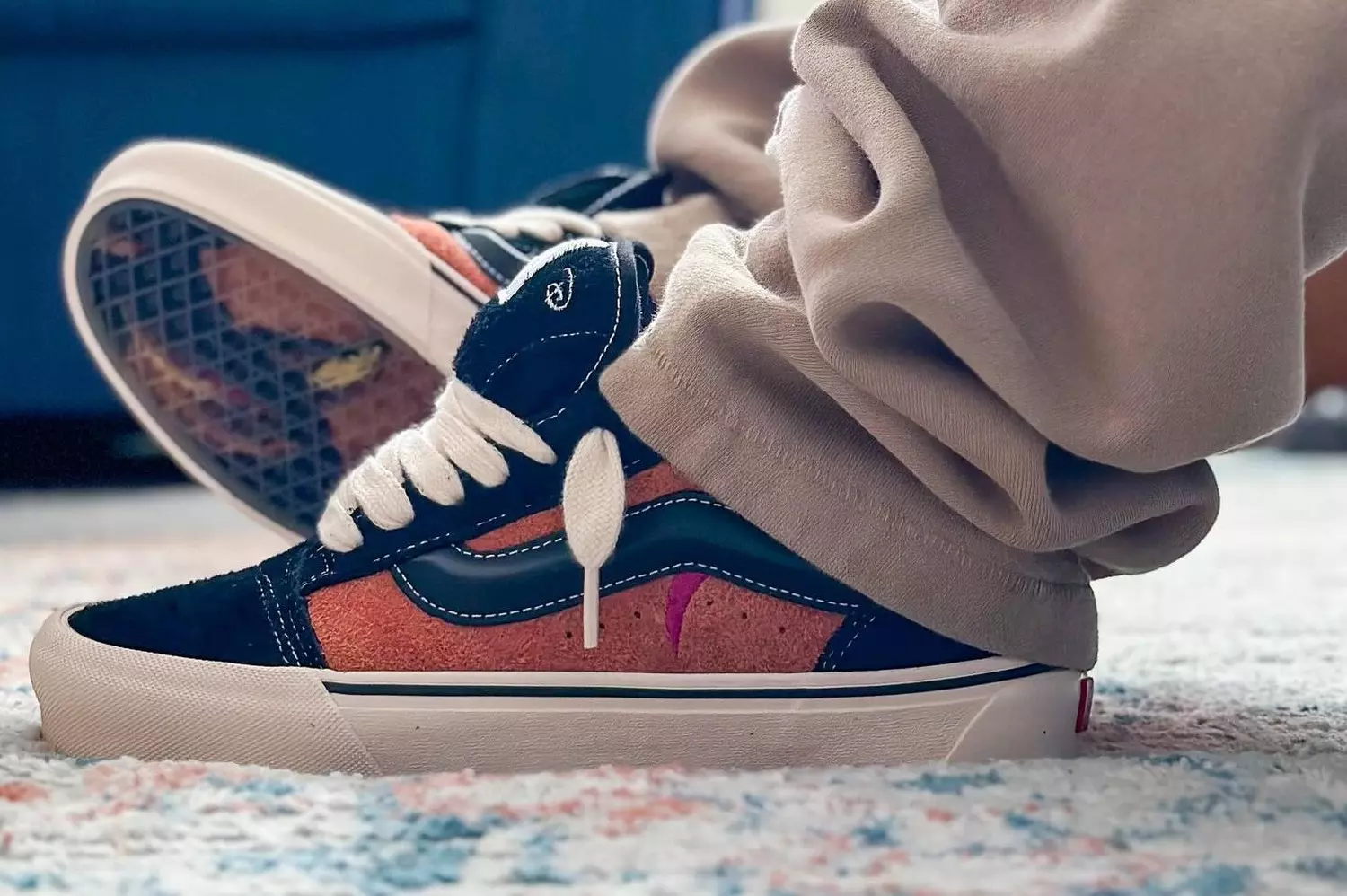
Converse: Dribbled from Courts to Subcultures
City of Origin: Malden, Massachusetts
Founded: 1908
For Whom: A classic loved by all
Converse is a brand that has become a symbol not only of American sports but also of street fashion. Since its founding in 1908 in Malden, Massachusetts, the company has strived to create footwear ideal for athletes. Initially, Converse specialized in producing sports shoes, particularly for basketball.
The history of Converse is inseparably linked to the name of Chuck Taylor, the legendary basketball player whose name and portrait became an integral part of the brand. Starting in 1921, Taylor was an official representative of the company, and his name became associated with one of the most famous sports products in the world — Chuck Taylor All Star.
Since its market debut in 1917, the Chuck Taylor All Star has become a true symbol of American culture and later a global cultural icon. These sneakers were worn not only by basketball players but also by other significant figures who transformed them into an essential part of street style.
Why Converse Is Timeless
- Versatility
Chuck Taylors go with absolutely any outfit. You can wear them with jeans and a T-shirt or pair them with a classic suit. That’s the magic of Converse — their style can be adapted to any situation, whether it’s an evening stroll or a hangout with friends. - Heritage
Converse is not just a brand. It’s an essential part of American culture and history. These sneakers have lived through multiple eras: from the euphoria of the '60s and the rock revolution to the punk movement of the '80s and the indie wave of the 2000s. Each time, they became a symbol of the next cultural shift. - Customization
Converse has always embraced creativity. You can design your own unique pair by choosing the color, print, materials, or even adding your own drawings. In recent years, Converse has actively developed its customization initiatives, allowing wearers to express their individuality and style. - A Bridge Between Subcultures
Converse has become a true bridge between different subcultures — from rock ‘n’ roll and punk to rap and indie rock. These sneakers are worn by everyone, from teens on the street to musicians on stage. Converse doesn’t divide — it unites people with different views and lifestyles.
Fun Facts
- Converse Chuck Taylor is the best-selling shoe of all time. These sneakers became more than just footwear — they turned into a global cultural phenomenon. Since their release, over a billion pairs have been sold worldwide, making them the top-selling shoe model in history. The numbers speak for themselves: Converse is not just a brand — it’s a true symbol of the times.
- In the 1960s, 90% of NBA players wore Converse. But in the 1980s, the brand lost ground to Nike and Adidas.
- But rock musicians "adopted" the sneakers: Kurt Cobain wore torn Chuck Taylors during Nirvana concerts, The Ramones made them part of their signature look, and Timothy Baltimore from Misfits used to draw skulls on them with a marker.
- During World War II, Converse produced footwear for the U.S. Army.
- In the 1980s, black Chuck Taylors became a symbol of punk and grunge movements.
- In 2003, the brand released a line with a sickle and hammer, which caused a scandal in the U.S.
- In 2008, the brand shot an ad featuring a live concert by The Strokes in a tiny store.
- A collaboration with Comme des Garçons (2012) turned the Chuck Taylors into a luxury must-have.
- In 2003, Nike acquired the nearly bankrupt Converse for $305 million. Instead of eliminating the competitor, Nike revived the iconic models, adding tech-enhanced versions (like the Chuck II with Lunarlon cushioning).
- Run Star Hike — a “hybrid” of platform and Chuck Taylor — became a hit on TikTok.
- In 2018, the brand set a record for the largest group skateboarding in Converse sneakers — 2,509 people simultaneously performed an ollie.
- Look closely at the sole pattern of classic Chuck Taylors: the circle and star reference a basketball, while the side lugs pay tribute to the first non-slip work shoe models.
- In “Back to the Future” (1985), Marty McFly was supposed to wear Nikes, but the actor insisted on Chuck Taylors — they fit the character better.
- In “Ghostbusters” (1984), Ray Stantz (Dan Aykroyd) wore a personal pair of Chuck Taylors.
- In 2017, Sotheby’s sold Kurt Cobain’s Converse from a 1993 Nirvana concert for $334,000. Bloodstains from a stage injury remained on them.
- In 2020, the brand released mini Chuck Taylor versions for pets, complete with tiny laces and the signature patch.
Converse has had a major influence not only on sports but also on music and street culture. Musicians across genres — from Kurt Cobain to Frank Ocean — have worn and continue to wear Converse, becoming style icons for generations of fans.
Every day, despite competition from other brands, Converse remains relevant — evolving with the world while staying true to its roots. New releases, limited editions, and exclusive collaborations with artists and designers keep the brand not just fashionable, but an essential part of global culture.
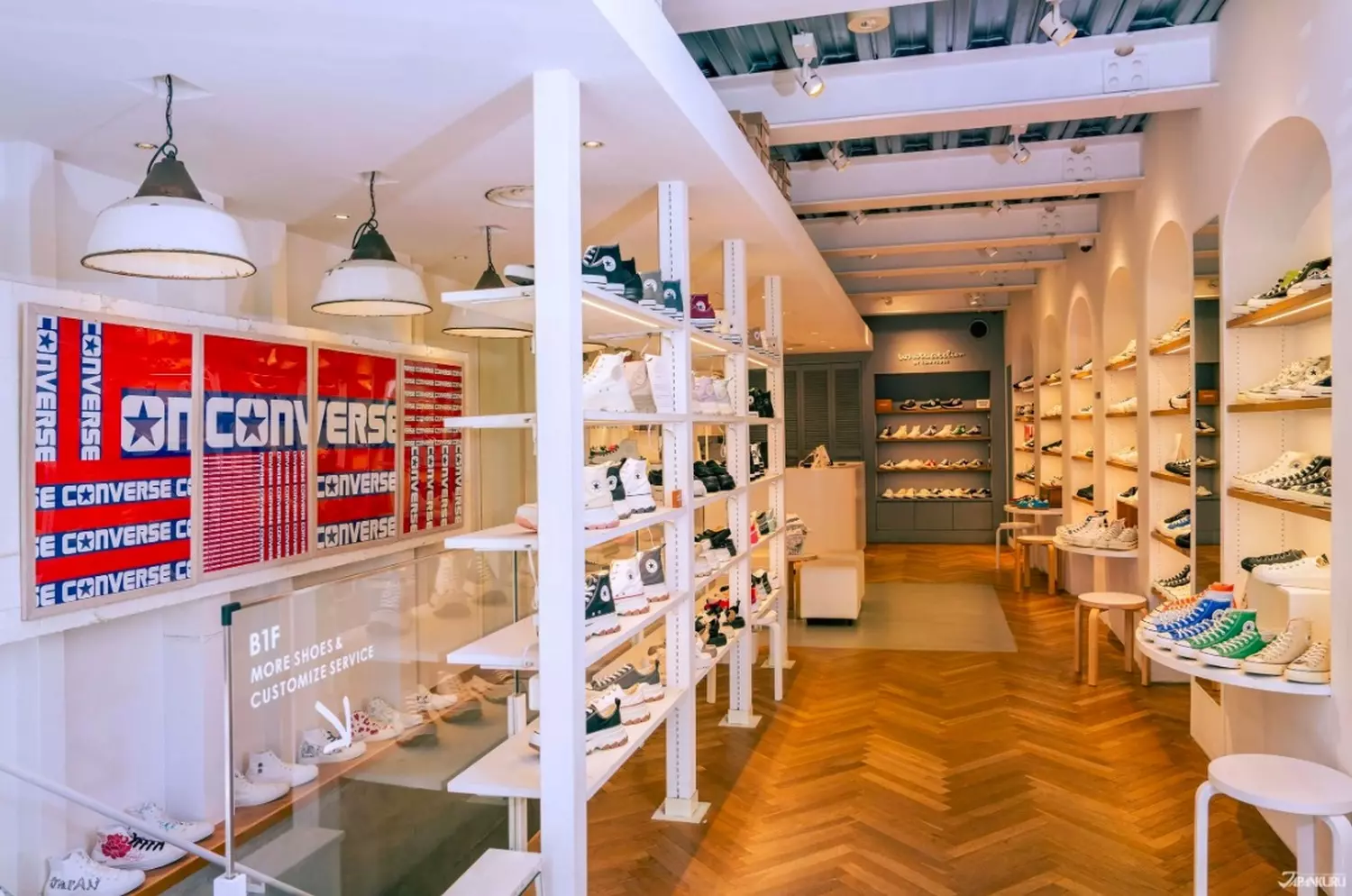
Where Wealth Shops: The Pinnacle of American Retail Luxury
Urban Outfitters: Big-City Style with a Retro Soul
Place of Birth: Philadelphia, USA
Year Founded: 1970
For Whom: Creative individuals, nonconformists, vintage lovers, and street style fans
Urban Outfitters is not just a clothing store—it's an entire cultural concept that continues to attract a growing number of fans around the world. Founded in 1970 in Philadelphia, the brand has, over several decades, become a symbol of an alternative lifestyle that blends the best of vintage trends, grunge, indie rock, and street chic.
When you walk into an Urban Outfitters store, you're immersed in a unique atmosphere where you can find not only stylish clothing but also one-of-a-kind home décor, accessories, and lifestyle products. It’s a place full of freedom, self-expression, and creativity—where everyone can discover something that speaks to their personality.
Why Urban Outfitters is More Than Just a Store
- A Mix of Styles and Eras
One of the key factors that sets Urban Outfitters apart from other brands is its ability to blend elements from different time periods. You’ll find retro-style pieces alongside modern fashion with a focus on minimalism and comfort. Iconic '90s items like distressed jeans, oversized tees, and sneakers go perfectly with today’s trends. - Support for Local Designers
Urban Outfitters consistently supports emerging and independent designers and artists. The brand frequently releases exclusive collaborations with street artists and niche fashion creators, helping keep the collections fresh and full of new ideas. - Focus on Individuality
Urban Outfitters doesn’t chase mass trends. It’s a brand for those who want to stand out. It celebrates uniqueness and self-expression. It attracts people unafraid to be themselves, to shape their own style, and to reject cookie-cutter fashion. - Unique Product Range
Urban Outfitters gained fame thanks to its diverse product selection. Beyond clothing, you’ll find home goods, aroma diffusers, books, vinyl records, and even vintage items. All of this makes the brand more than just a store—it’s a cultural hub. - Influence on Music and Youth Culture
Inspired by indie rock and punk music, Urban Outfitters often collaborates with bands and actively promotes street culture. It has become a favorite among youth who care about both their style and their lifestyle. - Retro and Nostalgic Vibes
It’s easy to find items at Urban Outfitters that evoke the spirit of the '90s—a style currently experiencing a massive revival. This includes vintage tees, denim jackets, and other pieces that capture the essence of that era.
Fun Facts
- Urban Outfitters is also known for its experimental approach to retail spaces. Some stores are designed as cultural venues, hosting art exhibitions, music events, and other gatherings that create a one-of-a-kind atmosphere and draw in young crowds.
- Founder Richard Hayne opened the first store under the name Free People (later renamed to Urban Outfitters), inspired by 1970s bohemian culture. The selection included used clothing, army surplus, and exotic trinkets—everything loved by hippies and punks.
- Urban Outfitters deliberately avoids a defined aesthetic, mixing: vintage (mom-fit jeans, reindeer sweaters), streetwear (oversized hoodies, New Balance sneakers), and kitsch (candles that smell like "L.A. smog", meme mugs).
- The brand isn’t afraid of controversy: in 2014 it sold tees stained to resemble blood (à la Kurt Cobain), and released yoga mats featuring maps of Palestine—leading to accusations of antisemitism. In 2020, it removed all items featuring the word "God" after complaints from atheist groups.
- In the 2000s, Urban Outfitters sponsored indie bands (The Strokes, Arctic Monkeys), turning some stores into concert venues.
- Today, the brand owns a vinyl label, "Urban Outfitters Records", which releases exclusive records (e.g., Billie Eilish albums on colored vinyl).
- Unexpected collaborations: Hello Kitty (Y2K-themed collection), NASA (sweatshirts with mission logos), Studio Ghibli (blankets and mugs featuring Spirited Away).
- Urban Outfitters is part of the URBN corporation, which also owns: Anthropologie (hipster luxury), Free People (boho chic), and Terrain (eco-lifestyle).
- In 2019, the brand launched a text-only website (no images), as a parody of digital burnout.
Urban Outfitters has become an important part of youth culture thanks to its aesthetics and fashion philosophy. The brand has created a space where individuality and self-expression are core values. It has inspired not only designers but an entire generation of people who value creativity and unconventional style. Urban Outfitters has become a cultural mainstay for those who follow trends and celebrate personal freedom.
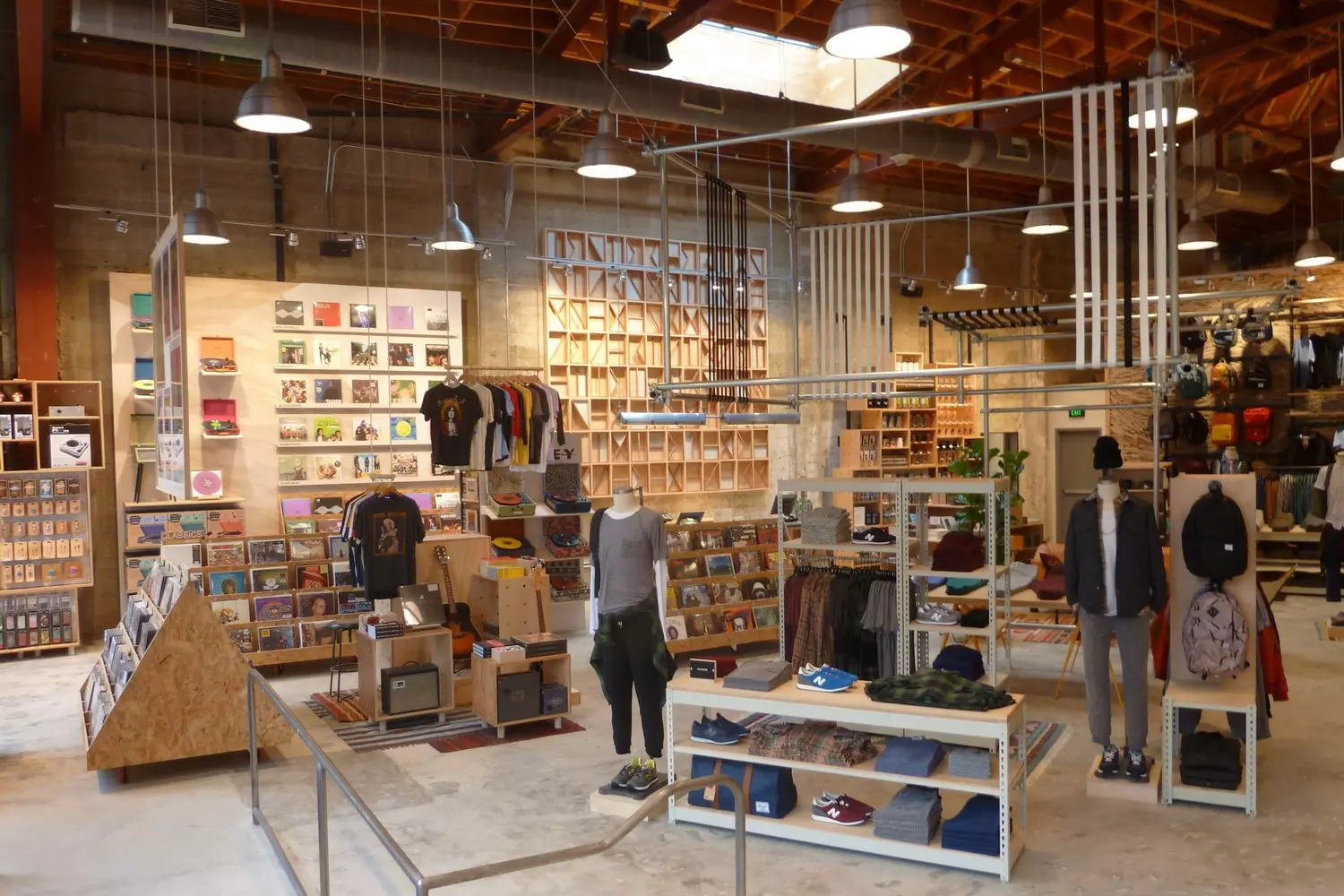
Hollister: Summer vibes all year round
Place of origin: Officially fictional, owned by Abercrombie & Fitch
Founded: 2000
Target audience: Youth inspired by beach culture, fans of casual style
Hollister is a brand that quite literally brings the vibe of a summer vacation into everyday life. It creates a feeling of endless summer, which is why it has become a favorite among teenagers and young people around the world. Hollister’s style is associated with bright sunshine, the sea, and the scents of coconuts and salty air. It's more than just clothing — it's a mood that transports you to a place where every day feels like summer.
Founded in 2000, Hollister became a part of Abercrombie & Fitch and from the very beginning set out to create a style that combines comfort with the latest trends in youth fashion. Unlike the more mature and formal Abercrombie & Fitch, Hollister is geared toward a younger audience, offering clothing that’s perfect for an active and carefree lifestyle.
Why Hollister Became a Favorite Among Youth
- The spirit of freedom and relaxation
Hollister designs instantly evoke thoughts of beaches and freedom. The brand’s signature pastel tones, soft fabrics, and light cuts are ideal for warm seasons. Hollister’s style is literally made for those who enjoy every moment. - Quality and comfort
Simple yet stylish cuts, natural fabrics, and attention to detail — all this makes Hollister clothes comfortable to wear all day long. Pants, T-shirts, shorts, dresses — every item is designed to be pleasant and easy to wear. - Relaxed aesthetic
All the brand’s collections are inspired by beach culture and a laid-back lifestyle. It’s a case where ease and style go hand in hand. The Hollister logo, in the form of a large seagull, symbolizes this freedom and dream of a simple yet vibrant existence. - Simple and comfortable cuts
The clothing doesn’t restrict movement and always looks clean and effortless, never adding unnecessary tension to the look. - Natural fabrics
Most pieces are made from cotton, linen, and other natural materials, which makes them not only stylish but also pleasant to wear. - Pleasant pastel tones and marine palette
Brand collections often include creamy, light blue, pink, and sandy tones, evoking the best summer days spent by the sea. - Clothing made for freedom
Hollister isn’t just a brand — it’s an ideology that embodies lightness and a free spirit. These clothes are perfect for young people who love adventure, aren’t afraid to be themselves, and value an active lifestyle. - Association with beach culture
The look of Hollister’s clothing is always linked to the idea of eternal summer, the sea, and the beach. While other brands often cater to certain subcultures or strict fashion standards, Hollister offers a relaxed, universal style that fits any occasion — from a beach day to hanging out with friends. - Youth subculture
Hollister has become a favorite among teenagers because it reflects the spirit of freedom and independence. These are clothes for those who want to stand out — without sacrificing comfort.
Interesting Facts
- The name Hollister comes from a fictional town in California created to reflect the atmosphere of American beach life and freedom. The name and its philosophy symbolize a place where everyone feels relaxed and harmonious. Interestingly, Hollister stores are designed like coastal beach houses with retro elements, turning shopping into a journey to summer.
- Every Hollister store smells like the ocean and sunshine — it’s thanks to a signature fragrance called SoCal (Southern California). The scent became so iconic that fans started buying body sprays and candles with it.
- In the 2000s, Hollister boutiques were intentionally dimly lit, played loud music inside, and store employees (who looked like models) greeted customers at the entrance. This created the feeling of an “exclusive club” that everyone wanted to be part of.
- Unlike other brands, Hollister didn’t hire professional models for ads. Instead, they selected “regular” guys and girls through casting calls at California high schools.
- In the 2010s, the brand’s popularity declined after being accused of promoting a “toxic” body culture (sizes were too limited). In 2017, Hollister brightened their stores, changed the logo, and started promoting body positivity.
- Collaborations with unexpected partners: Palm Angels (surf-punk-inspired capsule), YouTube bloggers (like the collection with Emma Chamberlain).
- In 2012, Hollister banned employees from saying “thank you” — instead, they were told to say “always” (as if you were a friend, not a salesperson).
- The brand was the first to launch beach delivery in California — you could receive your order right at the water’s edge.
Hollister has had a lasting impact on fashion, becoming a symbol of modern youth lifestyle. It not only defines beach style, but also actively shapes new trends in casual fashion. The brand has become a major player in the youth fashion industry and a part of that very “California dream” that for many represents the ideal life.

TOMS: Buy a Pair, Give a Pair
Place of origin: Santa Monica, California
Founded: 2006
Target audience: Ethical consumers, hipsters, students, eco-trendsetters
TOMS is a brand that combines style with kindness, offering not just shoes but a whole philosophy. Founded in 2006 in Santa Monica, California, the brand gained fame thanks to its social mission: "You buy — they give." Inspired by founder Blake Mycoskie’s trip to Argentina, where he saw children walking barefoot, TOMS decided to make the world a little better. With every pair of shoes sold, the company donates a pair to a child in need in a low-income country.
Today, thanks to its social initiatives, TOMS has become not only a symbol of comfort and fashion, but also a brand actively addressing global issues such as poverty and access to basic resources. It's more than just footwear — it’s a movement for justice and support for those in need.
Why Young People Choose TOMS
- Social mission
TOMS has become a symbol of social responsibility. Young people choose the brand because buying TOMS shoes allows them to participate in charity work, helping children in impoverished countries. It’s the perfect choice for those who want to make a positive impact and be part of a movement aimed at improving lives. - Comfort
One reason TOMS is popular among youth is their comfort and lightness. The shoes are made from soft, lightweight, and breathable materials, making them ideal for everyday wear. Comfortable sandals, slippers, and moccasins from TOMS suit all seasons and match any style easily. - Minimalist style
TOMS offers stylish yet simple designs that are easy to pair with any wardrobe. The brand is a great example of how minimalism and fashion can coexist with comfort. Their collections include both neutral and vibrant styles suitable for everyday wear or more formal occasions. - Eco-friendly approach
TOMS actively supports the use of recycled materials and sustainable manufacturing. In a world where environmental issues are increasingly relevant, the brand highlights the importance of caring for the planet. TOMS designs its shoes with an aim to minimize environmental impact, making the brand popular among environmentally conscious consumers.
Interesting Facts
- By 2020, TOMS had donated over 100 million pairs of shoes to children in need. This incredible number makes the brand one of the most recognized and successful in the field of social responsibility. Through this initiative, TOMS not only helps children, but also inspires other brands to follow its example and develop their own charitable projects.
- In 2007, TOMS appeared in Vogue — and sold 10,000 pairs in its first year.
- “White savior” — TOMS faced criticism for creating dependency rather than solving systemic issues.
- In 2014, the brand shifted its model: instead of giving away shoes, it started investing in local production and education programs.
- 2011 — TOMS launched eyewear. Each pair sold helps fund vision restoration procedures.
- 2014 — coffee collection launch. A portion of the profits goes to clean water initiatives.
- 2020 — the TOMS Social Entrepreneurship Fund supported startups aiming to change the world.
- Nordstrom — a limited edition collection featuring prints by artists from developing countries.
- Disney — Mickey Mouse on espadrilles, with part of the proceeds going toward education for girls.
- In 2019, the brand became fully vegan.
The brand has become a symbol of ethical fashion, inspiring millions of people to make the world a better place through their purchases. TOMS proved that a business can be both profitable and socially responsible. It set an example of how profit and purpose can go hand in hand — something especially important to today’s youth, who value not just style, but the meaning behind every choice they make.
In addition, TOMS actively develops other initiatives, such as clean water programs and support for women in difficult situations. This makes the brand a true leader among companies that not only sell products, but also create a platform for changing the world.
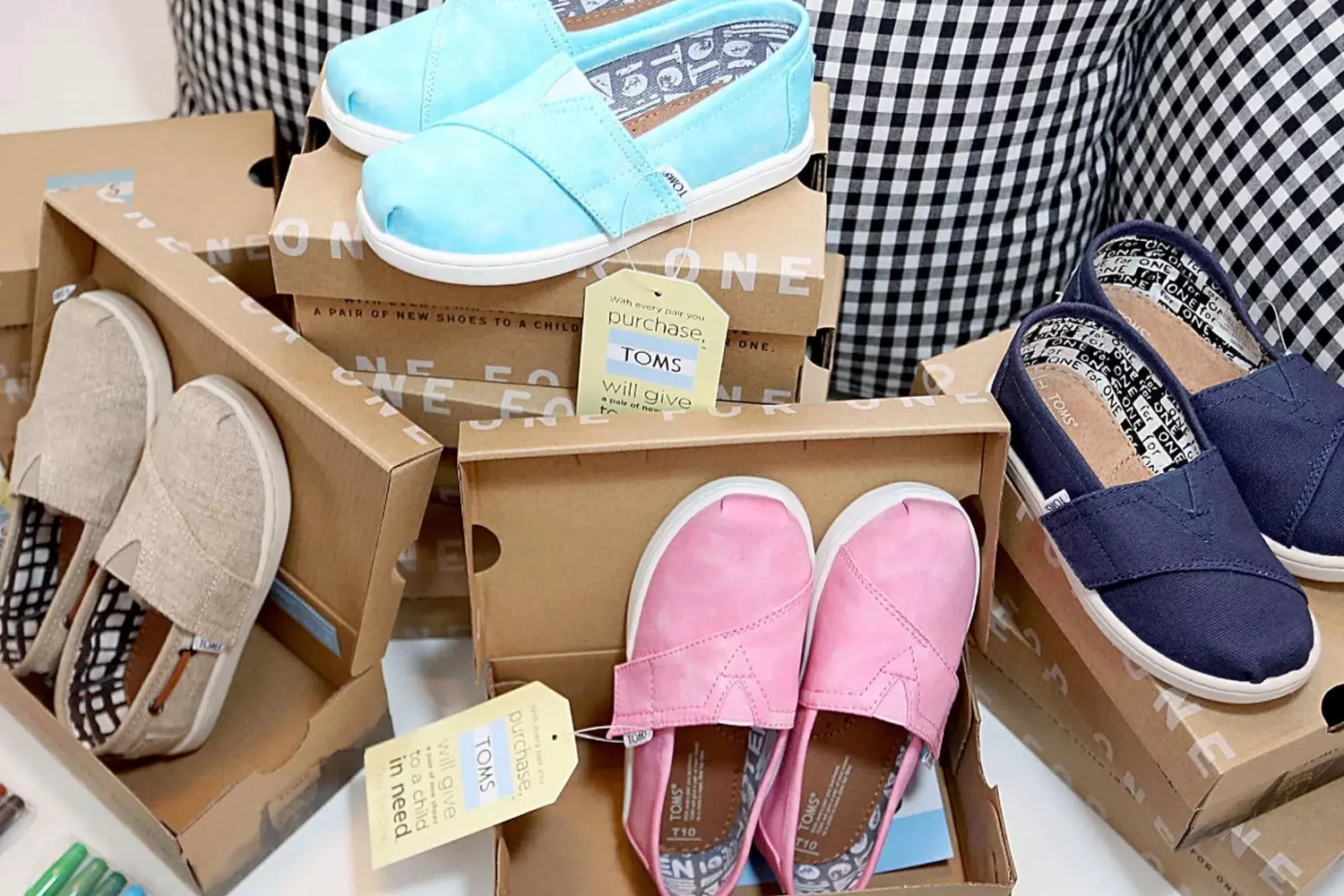
Champion: When athletic gear became hype
Place of origin: Rochester, New York
Founded: 1919
Target audience: Athleisure lovers, urban dwellers, old-school enthusiasts
Champion is a brand that began as a sportswear manufacturer and has evolved into a key player in street fashion and the athleisure movement. Inspired by athletic performance and comfort, Champion has undergone many changes over the years, yet remains true to the functionality and versatility that have made it beloved by people of all ages.
The story of Champion begins in 1919 in Rochester, New York. Originally, the company specialized in producing sportswear for professional athletes and active lifestyle enthusiasts. However, especially during the 1980s and 1990s, Champion carved out a firm place in youth culture, becoming a symbol of streetwear and retro trends. Today, the brand is strongly associated with comfort, vintage aesthetics, and athleisure — a style that blends sportswear with everyday fashion.
Why Is Champion Back in Style?
- Classic Design with a Vintage Vibe
Champion apparel has always been known for its old-school style. The brand’s signature “C” logo became a fashion icon in the 1980s and 1990s. As vintage styles make a comeback, Champion is once again at the height of popularity. This vintage aesthetic never goes out of fashion — instead, it returns in new interpretations. - High-Quality Materials and Details
Champion is recognized for its durability and premium materials. It’s not just gym gear — it’s stylish, comfortable clothing for everyday wear. The fabrics used are soft and cozy, while the hardware is reliable, making the pieces long-lasting and attractive. - Versatility — From Joggers to Skirts
One reason for Champion’s renewed popularity is its versatility. The brand blends sporty elements that easily fit into casual looks. Champion hoodies, t-shirts, and joggers pair well not only with sneakers but even with more formal shoes or skirts, creating unexpected yet fashionable outfits. This is the essence of athleisure — a trend that’s booming among youth who value both comfort and style. - Legacy of Sports Fashion
Champion has always been deeply rooted in sports. Starting as a uniform supplier for colleges and universities, the brand quickly became popular with students and professional athletes. Today, Champion’s athletic heritage continues to attract young people who see sports style as more than just about sports — it's about culture, lifestyle, and self-expression. - Legendary Collections
Some models, like the "Reverse Weave" (a fabric technique that prevents shrinkage), have become iconic and continue to attract fans of quality clothing even decades later.
Interesting Facts
- In the 1990s, when sportswear brands started to lose popularity, Champion made a bold move by introducing logo-fronted sportswear — a now-iconic element of the brand. This strategy was a breakthrough, and that style is trending again today.
- The brand originally launched as Knickerbocker Knitting Company, producing durable t-shirts for workers and soldiers.
- In the 1930s, the company was renamed Champion and became the official supplier of uniforms for U.S. college sports teams.
- The first hoodie (1930s) — the prototype of the modern hooded sweatshirt — was created by Champion.
- Reverse Weave technology (1938) prevents fabric shrinkage after washing.
- The first zip-up hoodie (1960s) — now a standard across all brands — was introduced by Champion.
- In the 1990s, Champion became the official uniform provider for the NBA. Legends like Michael Jordan and Shaquille O’Neal wore Champion gear during practice.
- In the 2000s, hip-hop artists like Jay-Z and Kanye West embraced the brand, turning it into a streetwear staple.
- In the 2010s, collaborations with Supreme, Vetements, Off-White brought Champion to the runway once again.
- Champion x Gucci (2020) — a luxurious reinterpretation of classic styles.
- The brand ranks among the top 5 most popular among youth (according to Lyst).
Champion is a brand that has stood the test of time, staying relevant through the decades. It proves that real style isn’t born on the runway, but on the streets and sports fields.
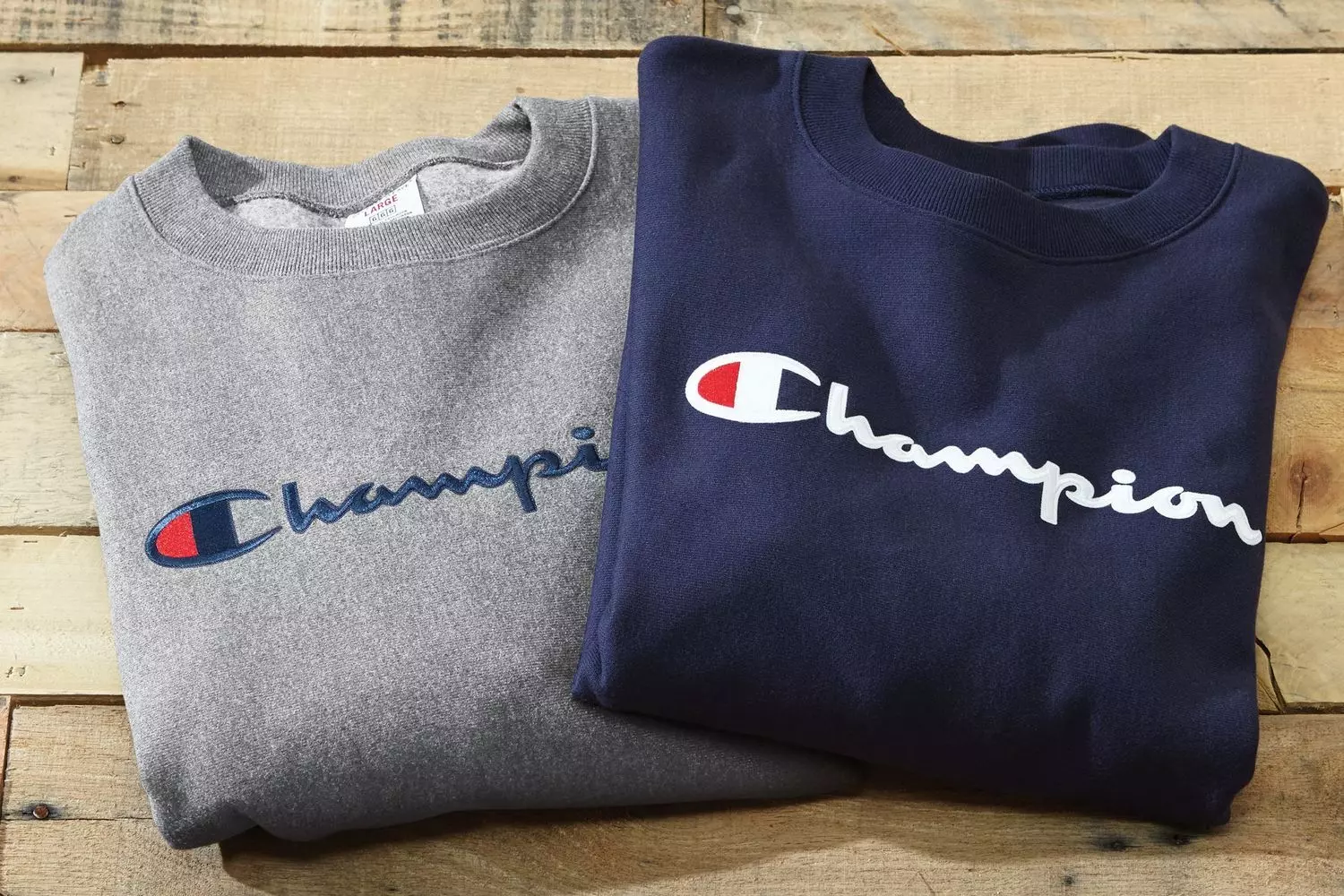
Stüssy: A Symbol of Street Culture
Place of origin: Laguna Beach, California
Founded: 1980
Target audience: Skaters, hip-hop fans, street artists, streetwear enthusiasts
Stüssy is more than just a brand — it's a lifestyle and philosophy born in California in the early 1980s. Founded by Shawn Stussy, the label immediately captured the attention of those immersed in street culture, skateboarding, and hip-hop. Today, Stüssy is rightfully considered one of the most influential brands in the streetwear world.
Stüssy's graphics and prints are signature elements of the brand. The logo — Shawn Stussy’s name scrawled in marker — has become an almost sacred symbol of street fashion. The brand soon came to represent more than just skatewear, attracting a broader audience that valued freedom of expression and a style unbound by mainstream trends.
Why Did Stüssy Become a Cult Brand?
- The Start of the Streetwear Revolution
When Shawn Stussy opened his first store in Laguna Beach in 1980, he had no idea he was creating a brand that would become the symbol of an entire fashion movement. Stüssy was one of the first brands to blend skate style with elements of street culture, creating unique looks that would soon be embraced by youth around the world. - Graphics and Art
Influenced by the spirit of hip-hop and California surf culture, Stüssy brought bold graphics and prints into streetwear. These featured vibrant and unconventional illustrations that would become iconic symbols. The hand-drawn logo still stands as one of the most recognizable in the world. Stüssy collections continue to experiment with graphic styles, from neon tones to abstract art and graffiti elements. - Collaborations with Other Brands
Stüssy has always stood out for its willingness to collaborate with iconic brands and artists. The label has teamed up with Nike, Vans, Supreme, and others who share its philosophy. These collaborations have not only expanded Stüssy's audience but also solidified its status, creating limited collections that became cultural artifacts. - Fanbase and Cult Community
From the beginning, Stüssy attracted those who sought more than just fashion — they were looking for values like freedom, self-expression, and rebellion against conformity. The brand built a cult following that has grown steadily. Its support from hip-hop artists, skaters, and graffiti creatives fostered a unique community where Stüssy apparel became a symbol of belonging to a subculture and living without limits.
Fun Facts
- Stüssy was one of the pioneers of the pop-up shop concept — a creative and practical way to open temporary stores in various locations around the world, a practice now widely adopted by other brands.
- It all started when Shawn used to tag his surfboards with his last name in graffiti style. Friends asked him to put the same logo on their shirts — and in 1984, the first capsule of 8 pieces was born.
- Stüssy was doing limited drops two decades before Supreme popularized the model.
- In the 1990s, Shawn created a secret club for friends of the brand. Membership was marked by a silver ring with the logo — DJs, artists, and future Supreme founders were on the list.
- 1991: Stüssy x Comme des Garçons — a revolutionary moment in street fashion.
- 2020: Stüssy x Dior — the brand’s most luxurious and expensive collaboration to date.
- Stüssy HQ holds an archive of over 5,000 vintage garments — from Japanese kimonos to military jackets.
- The brand follows a philosophy of “Invisible Fashion”: no advertising, no fashion week appearances, stores open only in the “right” neighborhoods.
Stüssy didn’t just make fashion more eccentric and informal — the brand became a symbol of a whole era in street culture, supporting youth rebellion and individualism. Its influence can be felt not just in clothing, but in music, art, and design. Stüssy is an integral part of what we now call street art — a movement that has profoundly shaped youth lifestyle over the past decade.
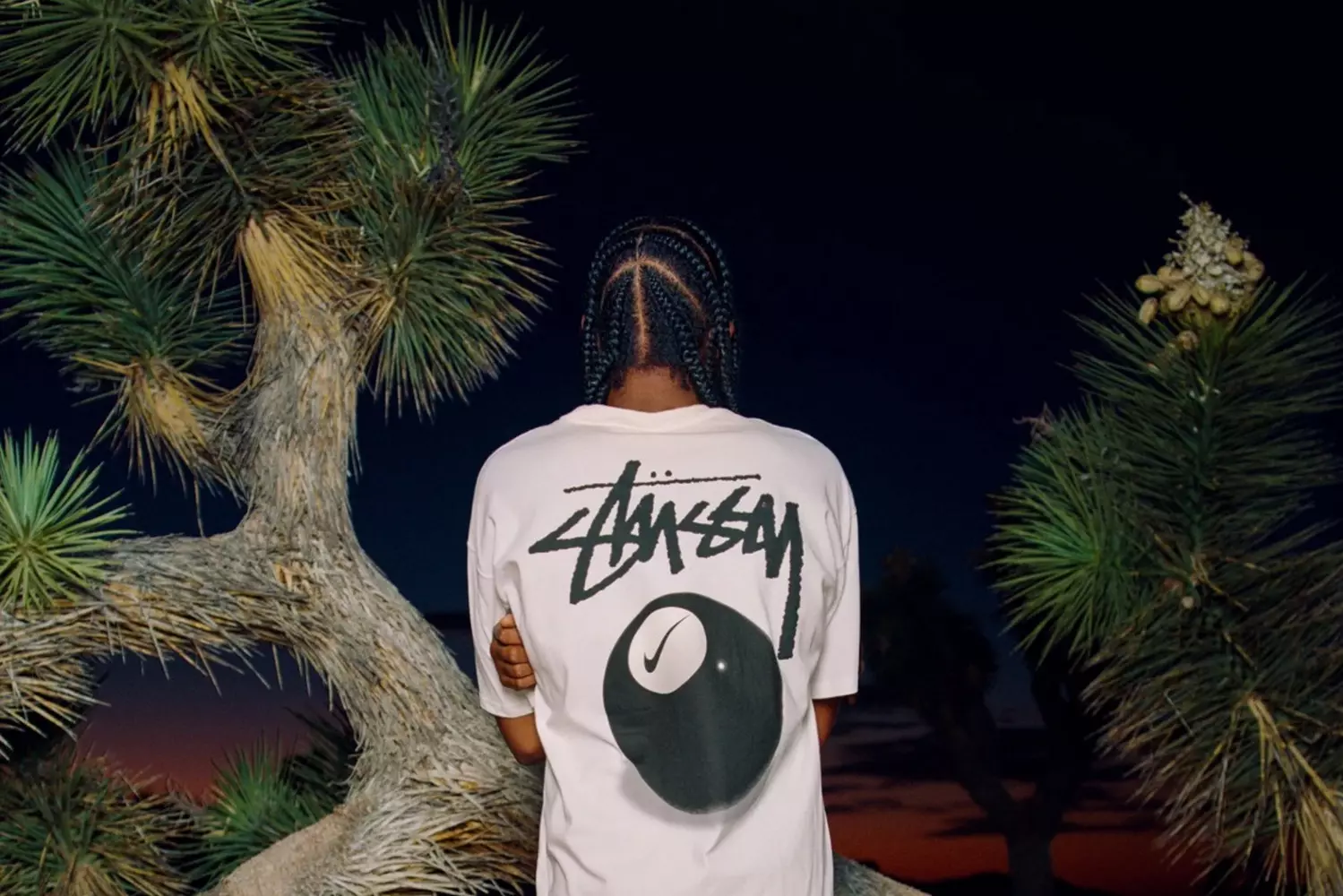
Guess: 90s Glam
Place of origin: Los Angeles
Founded: 1981
Target audience: Youth with a love for retro and sensuality
Guess is more than just a brand. It's an entire era that took us to a world of bright lights, parties, and the embodiment of sensuality in the 90s. Think of the iconic TV show “Beverly Hills, 90210”, and immediately the image of the female characters in stylish jeans and tops with the bright Guess logo, perfectly accentuating their figures, comes to mind.
The brand was founded in 1981 by three French brothers, initially focusing on denim production. Guess quickly became iconic due to its unique approach to denim and its use of bold, vibrant accents in design that set them apart from other brands of the time.
Why Guess is Back in Fashion
- The Return of the 90s
Guess became the defining brand for the youth of the 90s. With its figure-hugging jeans, tops, and bold logo, the brand embodied glamour, sexiness, and affluence. In recent years, we've seen a return of retro fashion, and Guess is back in the spotlight. This is not just a trend—it's a return to the culture and lifestyle of that time. - Image of Sensual Confidence
Throughout its history, Guess has maintained its reputation as a brand that highlights sensuality and self-confidence. Their famous campaigns featuring models and actresses like Claudia Schiffer and Carla Bruni not only showcased the clothing but also created an entire lifestyle. Guess is not just about fashion; it's about showing your personality. The main focus of Guess has always been on denim, especially form-fitting jeans. These jeans were a symbol of sensuality and confidence, and the style allowed one to emphasize shape and elegance. The brand also actively uses denim jackets and shorts that pair well with almost any other wardrobe pieces. - Iconic Logo and Style
The Guess logo has become an integral part of street fashion. Its brightness, simplicity, and appeal immediately attract attention. Clothing featuring the Guess logo became a symbol of status while remaining accessible to the youth who wanted to express their individuality. - Variety of Models
The brand offers not only classic denim models but also vibrant tops, dresses, and jackets, allowing you to create a wide range of looks, from casual to evening.
Fun Facts
- The first collection of 72 pairs of jeans was sewn by the Marciano brothers in their kitchen in Los Angeles.
- The secret to their success: the tight-fitting cut (at a time when baggy styles were in) + the signature triangular patch on the back pocket.
- Photographs by Herb Ritts for Guess became the epitome of erotic advertising in the 90s.
- In the 90s, Guess created a "virtual factory": design in Los Angeles, production in 200 factories across 60 countries, which resulted in lawsuits over slave labor in Saipan (1999) and a $1 million fine.
- Iconic pieces that shook the fashion world: the "Marilyn" jeans (1990) — with a low waist and knee slashes, the "Marciano" watch (1984) — the first designer watch priced at $100, Guess? perfume (1990) — a bottle shaped like a denim rivet.
- The "Twin Peaks" capsule collection (2021) — a tribute to the iconic series, which dressed the characters in Guess.
Guess is a brand that remains a symbol of sensuality, freedom, and self-expression. It takes us back to the 90s, when style was bold, and fashion expressed personality. The youth that appreciates retro style, glamorous elements, and the ability to make a statement through clothing is once again finding a loyal ally in Guess. It's not just a brand, it's a part of the culture.
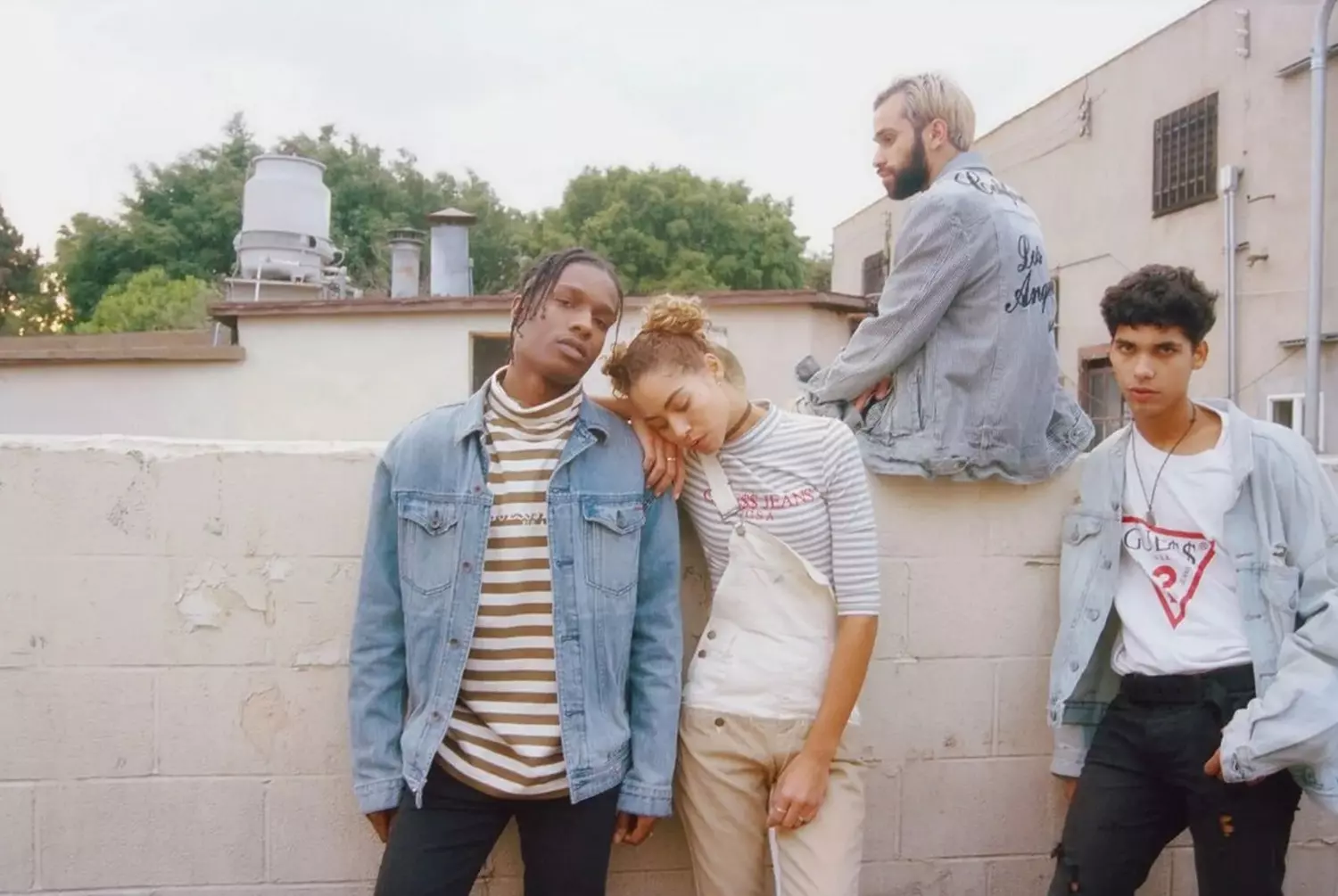
Obey: Art and Protest
Place of origin: Southern California
Founded: 2001
Target audience: Socially active youth, fans of contemporary art, street culture enthusiasts, and activists
Obey is a brand that carries not only style but also deep social messages. Created by American artist Shepard Fairey, it became known for its bold graphic images and slogans that often address political and social issues. Its most famous work is the iconic poster featuring Barack Obama with the word "Hope", which became a symbol of hope during the 2008 presidential campaign.
The philosophy of Obey is not limited to clothing. It is a life stance, a call for social activism, and a protest against the system. In every item of the brand, whether it's a t-shirt, hoodie, or cap, there is a hidden meaning that encourages reflection on global issues.
Why Obey Became an Important Brand in Street Culture
Obey quickly became a symbol not only of streetwear but also of the global movement for social change. The brand carries ideas that make people think about the current political situation and call for action. From the very beginning of his work, Fairey began using street graffiti and posters as a way to spread his views. At some point, his works became so popular that the Obey brand transitioned into the world of fashion.
- Graphics and Cultural Influence
Famous graphic prints and posters are not just images but a whole philosophy underlying the brand. Shepard Fairey uses recognizable images in his work, such as the famous image of President Obama with the word "Hope," as well as symbols of anarchy, revolution, and criticism of the political system. - Slogans and Messages
The brand actively uses its slogans to spread social messages. One of the most famous is the statement "The medium is the message". This philosophical approach indicates that the brand, as part of mass culture, has the ability to influence public consciousness, regardless of how it is perceived. One of the most striking statements by the brand is that clothing is not just an item but a tool of protest. - Political Art and Mass Culture
Obey clothing is not just a fashion choice; it's a way to make a statement about your views. In this context, clothing has become not only a form of self-expression but also a tool of political struggle. For example, many of the brand's collections highlight issues such as human rights, racism, wars, and social injustice. - Encouraging Action
Obey also promotes activism on all levels. Fairey emphasizes that the youth must be ready to act. The brand’s collections and posters often serve as a platform for social movements, such as Black Lives Matter, environmental protests, and global human rights initiatives.
Fashion trends change, but what Obey offers to the youth is the opportunity to express their personal stance through style. For many, the brand has become a symbol of activism and a "flag of freedom" for those who are not afraid to voice their opinions. For those who value not only style but also deep meaning in their clothing, Obey has been a real discovery. It’s not just a brand to “stay on trend,” but part of a larger cultural revolution where youth seek ways to express their views through style.
Fun Facts
- In 1989, Fairey created a sticker featuring wrestler André the Giant — a parody of Soviet agitprop posters.
- The slogan "Obey Giant" referenced the cult film "They Live" (1988), where characters saw hidden propaganda in the media.
- Each collection is a social commentary: prints with civil activists (Martin Luther King, Che Guevara), collages from military archive photos, slogans like "Manufactured Dissent" (artificially created protest).
- Obey x NASA (2018) — a capsule with Apollo mission patches, with 10% of profits going to scientific grants.
- In 2012, Dubai police arrested a person for wearing an Obey t-shirt featuring a Palestinian activist.
- 50% of collections are limited capsule collections with artists and NGOs.
- Gallery-stores in Los Angeles and Berlin host exhibitions of young activists.
Obey is not just a clothing brand but a cultural and political phenomenon. The brand continues to influence youth worldwide, calling for activism, awareness, and self-expression. If you’re looking for not just fashionable clothes but a tool to express your social views, Obey is an excellent choice.
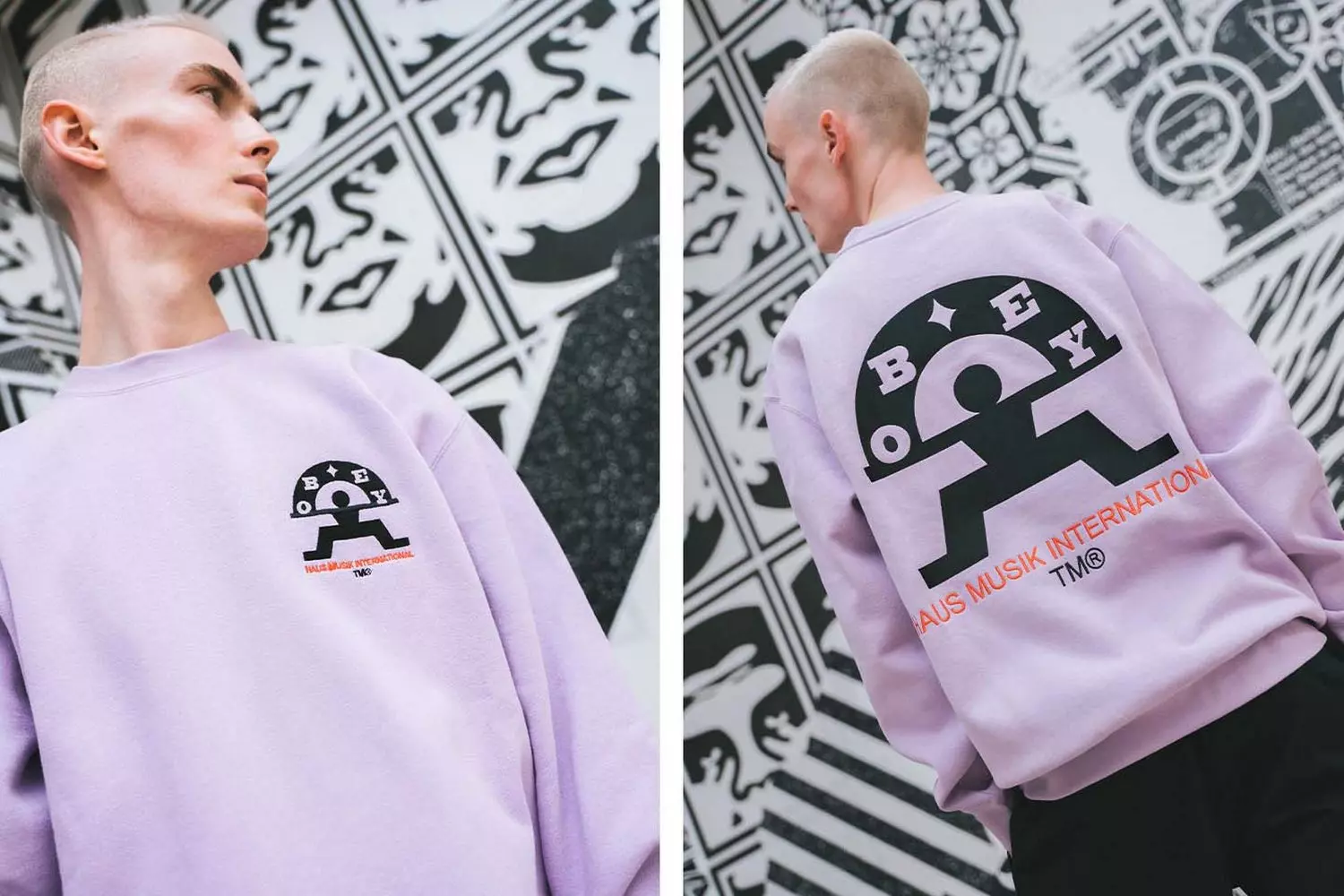
Brandy Melville: Minimalism for Teenagers
Place of origin: Los Angeles
Founded: 2009
Target audience: Teenage girls, fans of pastel shades and light fabrics
Brandy Melville is a perfect example of how simple and effective it can be to create a stylish brand targeted at a young audience by focusing on minimalism and pastel tones. Since its foundation in 2009, the brand has quickly captured attention with its unique design philosophy: clothing that is perfect for creating soft, “effortless” looks that highlight individuality and freedom.
However, as appealing as the brand is, it has faced considerable criticism, especially regarding its size policy, where "one size fits all." This means that most of the clothing items have a limited size range, which can create problems for people with non-standard body types. This aspect makes the brand quite controversial, especially for those who find its size policy too restrictive.
The key element of Brandy Melville's style is pastel shades and light fabrics that create an atmosphere of relaxation and romance. Light tops, loose skirts, comfortable sweaters, and simple jeans — all these items can easily be combined to create a stylish yet casual look. The brand is especially known for its classic youth aesthetic with elements of sweet romance and effortless street style.
Why Brandy Melville is so popular among teenagers
- Tumblr Aesthetic
The style of Brandy Melville is closely associated with the aesthetic popular on the Tumblr platform, where fans of minimalism and pastel shades post their photos and create collections. The brand fits perfectly into this atmosphere, offering clothing that reflects the subtle, light, and cozy images typical of online culture. - Comfort and Versatility
The clothing from Brandy Melville is suitable for daily wear. It is versatile and easy to mix and match, creating a variety of looks — from casual to more stylish options. Young people appreciate these items for their comfort, as well as for their ease of care. - Suitable for various everyday situations
This clothing doesn’t require much effort in terms of styling — just pick a few basic items, and you'll have a stylish outfit for school, a walk with friends, or even a party.
Fun Facts
- The name Brandy Melville is actually not associated with any specific person. It was chosen as a catchy and stylish name for the brand. Despite being founded in Los Angeles, the brand quickly became international and gained huge popularity among youth, including in Europe and Asia.
- Brandy Melville’s clothes are only made in size S (or 25-26 jeans) — allegedly "for the average girl." In reality, this is a size 0-2 (XS-S), which sparked criticism for promoting unrealistic standards. In 2021, the brand secretly introduced “plus sizes” (up to L), but sells them only online and doesn’t publicize it.
- Stores hire only girls who fit the brand’s aesthetic: slim, with long hair, "natural" makeup (but in reality — full glam). They wear the brand's clothing, manage social media, and become local celebrities.
- Marketing techniques: no ads — only word of mouth via TikTok and Instagram, no mannequins — clothes are hung on racks, and you either fit or you don’t, “secret” new arrivals — some items appear in stores without an announcement and disappear after a week.
- Cult items that everyone went crazy for: Cara skirt — a plaid mini skirt, which was in every “morning chair” in American schools, "Ana" jeans — high-waisted and “breathing” fabric (but actually terribly tight), t-shirts with the slogans "LA", "Brandy" — these were even replicated by luxury brands.
- In 2020, former employees accused the brand of racist hiring practices (only hiring “white and slim” girls).
Brandy Melville is a symbol of youth minimalism and carefree style. Despite the criticism over size limitations and high prices, the brand continues to be beloved by teenagers for its accessibility, comfort, and simplicity. If you want to look stylish without being too flashy, Brandy Melville is the perfect choice.
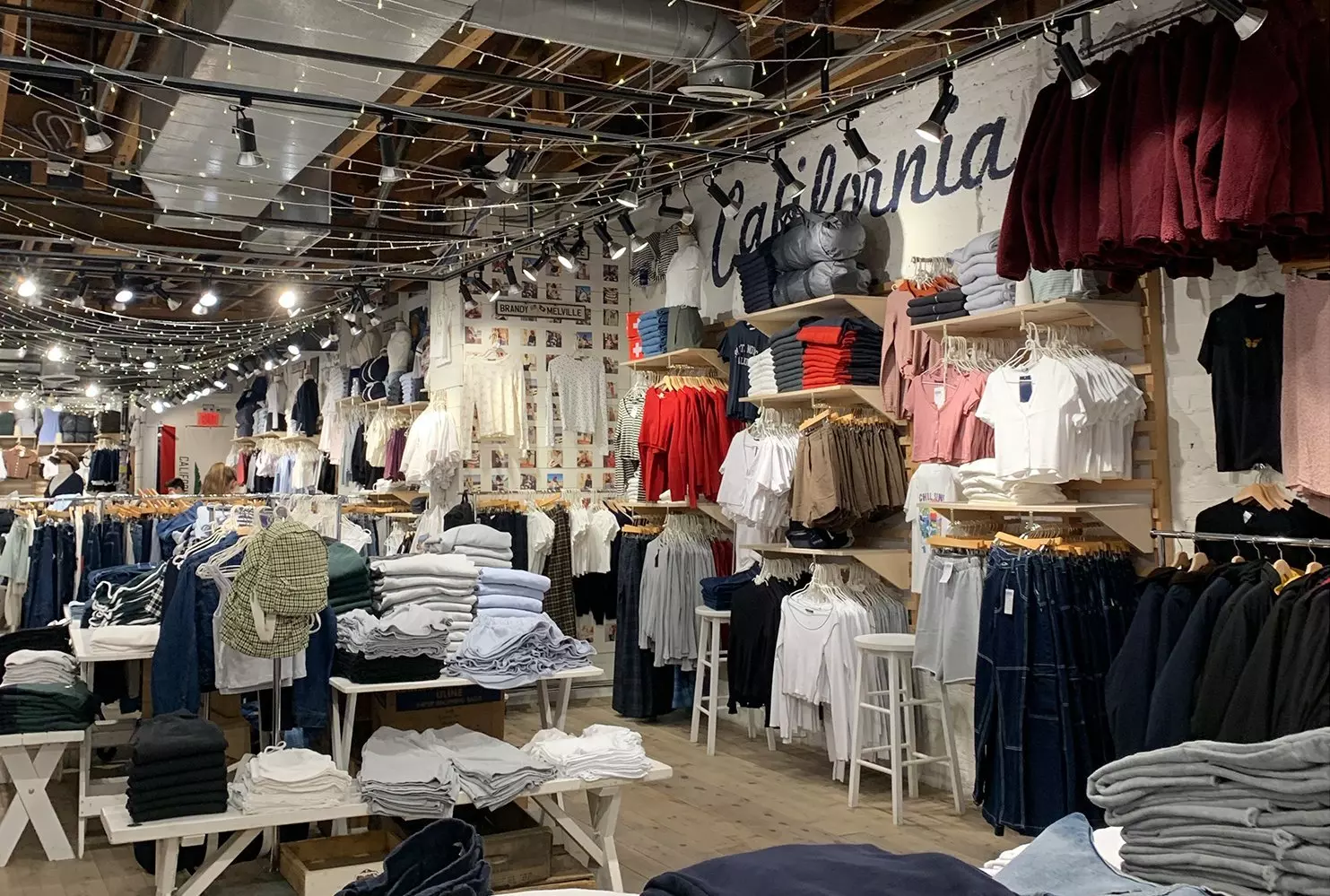
American Butler — your personal stylist and guide to fashionable America
American youth fashion is not just about jeans and hoodies. It's about symbols of belonging, a way to stand out or, conversely, blend in with your crew. It's an endless conversation with the surrounding world: through a logo on your chest, the fit of your pants, or the color of your sneakers.
And if you want to immerse yourself in this atmosphere — to be on trend, feel the pulse of the street and city — we can help.
Want to visit the best stores in the USA? Curate a wardrobe in the style of Supreme or Hollister? Set up a personal shopping tour in Los Angeles or New York?
We can help you with:
- Organizing a trip with a customized program
- Booking visits to showrooms and boutiques
- Selecting a stylist and personal image consultant
Experience American fashion from the inside — with comfort, style, and attention to detail. With American Butler.






























